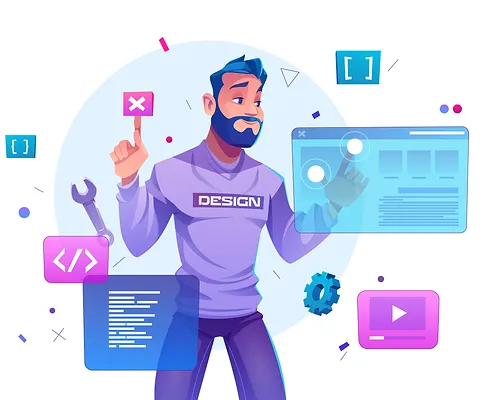Mastering Wix Website Design and Development: A Comprehensive Guide by StarWebTek

Welcome to StarWebTek’s guide on mastering Wix website design and development. In this comprehensive resource, we’ll explore everything you need to know about creating stunning and user-friendly websites using the Wix platform. From understanding the basics of Wix to mastering advanced design techniques and optimizing for the best user experience (UI/UX), we’ve got you covered.
Introduction to Wix
Wix is a popular website builder that empowers users to create professional-looking websites without any coding knowledge. With its intuitive drag-and-drop interface and a vast array of customizable templates and features, Wix has become a go-to choice for individuals and businesses looking to establish an online presence quickly and easily.
Why Choose Wix for Your Website?
- User-Friendly Interface: Wix offers an intuitive drag-and-drop editor that makes it easy for users of all skill levels to design and customize their websites.
- Vast Template Library: With hundreds of professionally designed templates covering various industries and niches, Wix provides ample options to kickstart your website design.
- Flexible Customization: Wix allows for extensive customization, enabling users to personalize every aspect of their website to match their brand identity and style.
- Powerful Features: From e-commerce capabilities and blogging tools to advanced SEO features and integrations, Wix offers a wide range of features to enhance your website’s functionality.
- Affordability: Wix offers flexible pricing plans to suit different budgets, making it accessible to individuals, small businesses, and enterprises alike.
Understanding UI/UX Design Principles
Before diving into Wix website design and development, it’s essential to grasp the fundamentals of UI/UX design. User Interface (UI) design focuses on the visual layout and elements of a website, while User Experience (UX) design concerns the overall usability and satisfaction of users interacting with the site.
Key UI/UX Design Principles
- Simplicity: Keep the design clean and uncluttered to avoid overwhelming visitors.
- Consistency: Maintain uniformity in design elements, such as colors, fonts, and navigation, to create a cohesive user experience.
- Navigation: Ensure intuitive navigation paths to help users find what they’re looking for quickly and easily.
- Visual Hierarchy: Prioritize content hierarchy to guide users’ attention and emphasize essential elements.
- Accessibility: Design with accessibility in mind to accommodate users with disabilities and ensure an inclusive experience.
Wix Website Design Basics
Now that we’ve covered the fundamentals of UI/UX design, let’s delve into the specifics of designing a website on the Wix platform. Whether you’re starting from scratch or revamping an existing site, these steps will guide you through the process of creating a visually appealing and user-friendly website on Wix.
Step 1: Choosing the Right Template
- Exploring the Template Gallery: Browse through Wix’s extensive collection of templates categorized by industry, style, and functionality.
- Considering Your Brand Identity: Select a template that aligns with your brand’s aesthetics, tone, and objectives.
- Customizing the Template: Personalize the chosen template by modifying colors, fonts, images, and layout to reflect your brand identity and style.
Step 2: Designing Your Website
- Layout and Structure: Plan the layout and structure of your website, including pages, sections, and navigation menus.
- Visual Elements: Incorporate visually appealing elements such as images, videos, graphics, and animations to enhance engagement and storytelling.
- Typography: Choose appropriate fonts that are legible and complement your brand’s personality and message.
- Color Scheme: Establish a cohesive color scheme that resonates with your brand identity and evokes the desired emotions and associations.
Step 3: Optimizing for Mobile Responsiveness
- Mobile-Friendly Design: Ensure that your website is optimized for mobile devices, providing a seamless and intuitive experience across various screen sizes and resolutions.
- Responsive Design: Use Wix’s responsive design features to adapt content and layout dynamically based on the device accessing the site.
- Testing and Iteration: Test your website across different devices and screen sizes to identify any usability issues or layout discrepancies and make necessary adjustments.
Step 4: Integrating Functionalities and Features
- E-commerce Integration: If applicable, set up an online store on your Wix website using built-in e-commerce features or third-party apps and extensions.
- Contact Forms and Lead Generation: Include contact forms, subscription forms, and lead generation tools to capture visitor information and facilitate communication.
- Social Media Integration: Integrate social media buttons and feeds to encourage social sharing and engagement, expanding your online presence and reach.
Step 5: SEO Optimization
- On-Page SEO: Optimize your Wix website for search engines by incorporating relevant keywords, meta tags, and descriptions into your content and optimizing page titles, URLs, and headers.
- Performance Optimization: Improve website speed and performance by optimizing images, minimizing code, and leveraging caching and compression techniques.
- Mobile Optimization: Ensure that your website is mobile-friendly and adheres to Google’s mobile-first indexing guidelines to maintain visibility in search results.

Advanced Wix Website Design Techniques
Once you’ve mastered the basics of Wix website design, you can explore advanced techniques and strategies to elevate your site’s visual appeal, functionality, and user experience further.
Advanced Design Features
- Parallax Scrolling: Create dynamic and immersive scrolling effects using Wix’s parallax scrolling feature to captivate visitors and enhance storytelling.
- Animation and Interactivity: Incorporate animations, hover effects, and interactive elements to add visual interest and engagement to your website.
- Custom CSS and HTML: Utilize custom CSS and HTML coding to achieve unique design elements and functionalities beyond the limitations of Wix’s built-in tools.
User Experience Optimization
- User Testing: Conduct user testing and gather feedback to identify usability issues, pain points, and areas for improvement in your website’s design and functionality.
- Accessibility Compliance: Ensure that your website meets accessibility standards and guidelines to accommodate users with disabilities and provide an inclusive user experience.
- Performance Monitoring: Continuously monitor and analyze website performance metrics, such as load times, bounce rates, and conversion rates, to optimize user experience and achieve business objectives.
Wix Website Maintenance and Support
Creating a Wix website is just the beginning. To ensure its long-term success and effectiveness, ongoing maintenance and support are essential. Whether it’s updating content, troubleshooting issues, or implementing new features, proactive maintenance and responsive support can help keep your Wix website running smoothly and efficiently.
Maintenance Best Practices
- Content Updates: Regularly update and refresh website content to keep it relevant, accurate, and engaging for visitors.
- Security Patches: Install security patches and updates promptly to protect your website from vulnerabilities and potential security threats.
- Performance Optimization: Continuously monitor and optimize website performance to maintain fast loading times and smooth user experience.
- Backup and Recovery: Implement regular backups to safeguard against data loss and ensure quick recovery in case of unexpected issues or emergencies.
Support Services
- Technical Support: Provide timely and responsive technical support to address user inquiries, troubleshoot issues,
